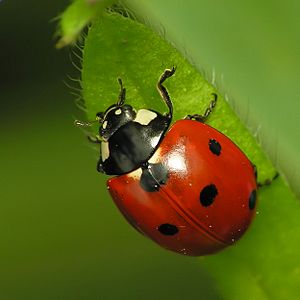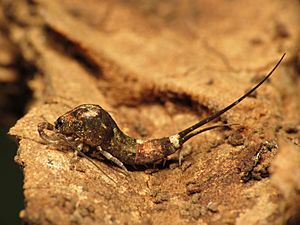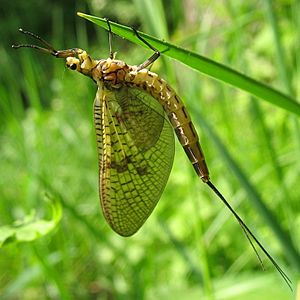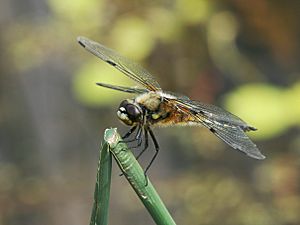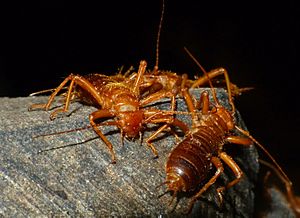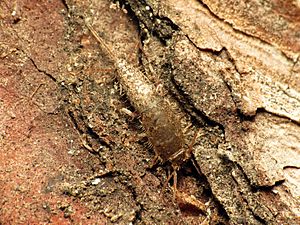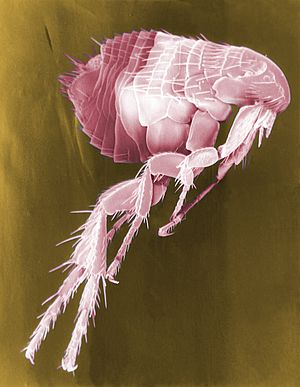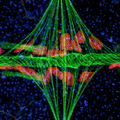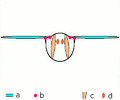Insect facts for kids
Quick facts for kids Insects |
|
|---|---|
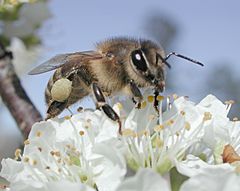 |
|
| A bee on a flower | |
| Scientific classification | |
| Kingdom: | |
| Phylum: | |
| Subphylum: | |
| Class: |
Insecta
Linnaeus, 1758
|
Insects, are a class in the phylum Arthropoda. They are small terrestrial invertebrates which have a hard exoskeleton. Insects are the largest group of animals on earth by far: about 926,400 different species have been described. They are more than half of all known living species. They may be over 90% of animal species on Earth.
New species of insects are continually being found. Estimates of the total number of species range from 2 million to 30 million.
Insects have six legs; and most have wings. Insects were the first animals capable of flight. As they develop from eggs, insects undergo metamorphosis. Insects live all over the planet: almost all are terrestrial (live on land). Few insects live in the oceans or in very cold places, such as Antarctica. The most species live in tropical areas.
Some people call all insects "bugs", but this is not correct. Only some insects are true bugs, which is a particular order of insects. People who study insects are called entomologists.
Contents
Insect bodies

A- Head B- Thorax C- Abdomen
2. ocelli (lower)
3. ocelli (upper)
4. compound eye
5. brain (cerebral ganglia)
6. prothorax
7. dorsal blood vessel
8. tracheal tubes (trunk with spiracle)
9. mesothorax
10. metathorax
11. forewing
12. hindwing
13. mid-gut (stomach)
14. dorsal tube (Heart)
15. ovary
16. hind-gut (intestine, rectum & anus)
17. anus
18. oviduct
19. nerve chord (abdominal ganglia)
20. Malpighian tubes
21. tarsal pads
22. claws
23. tarsus
24. tibia
25. femur
26. trochanter
27. fore-gut (crop, gizzard)
28. thoracic ganglion
29. coxa
30. salivary gland
31. subesophageal ganglion
32. mouthparts
Insects have exoskeletons (skeletons on the outside). Their skeletons are made out of thin, hard pieces or plates, like armour, made of chitin. All together, these pieces make a hard layer around the insect’s body. The exoskeleton protects the insect.
The body of an insect has three main parts: a head, a thorax, and an abdomen. On the head are an insect’s compound eyes, its two antennae (they feel and smell things), and its mouth.
On the thorax, insects have wings and legs. All insects have six legs (three pairs of jointed legs) and usually four wings (two pairs).
The abdomen is the back part of the insect. Inside the abdomen is the stomach, the heart, and the excretory system where body wastes pass out of the insect. Bees also have a stinger at the back of the abdomen.
Physiology
Just like our muscles connect to our bones to make us walk and stand up, the muscles of an insect connect to the exoskeleton to make it walk and move. Their muscles are on the inside of their skeleton.
Insects are cold-blooded, which means that they cannot control their body temperature. This means that insects are not good at surviving the cold, at any rate out in the open. In the winter, many insects go into something called diapause, which is the insect version of hibernation. Some insects, like cockroaches, cannot go into diapause and they will die if it gets too cold outside. This is why cockroaches love living in people's warm houses.
Respiratory and circulatory systems

Insect respiration happens without lungs. There is a system of internal tubes and sacs through which gases diffuse or are actively pumped. Air is taken in through openings on the sides of the abdomen called spiracles. Oxygen gets to tissues that need it through their trachea (element 8 in diagram). As larvae, many insects have gills that can extract oxygen dissolved in water, while others need to rise to the water surface to replenish air supplies which may be held or trapped in special structures.
Adult insects use oxygen at a high rate when they fly. They need it for the flight muscles, the most active tissue known in biology. The flight muscles use oxygen at a huge rate: 100 ccs of oxygen for every single cc of tissue per hour. With this system, the greatest diameter a muscle could have (and still consume oxygen at this rate) is about 0.5cm. Even with special extra arrangements, insects cannot get larger than about 11cm long. The largest insect bodies are about as big as a mouse.
Some insects also use a molecule called haemocyanin, which does the same job as haemoglobin does in vertebrates (but less efficiently). The insect circulatory system has no veins or arteries. The 'blood' is called haemolymph, and moves around in the space called the haemocoel. The organs sit in the haemocoel and are bathed in the haemolymph. The 'heart' is little more than a single tube which pulses (squeezes).
How insects grow
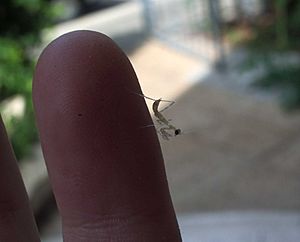
Insects start life as an egg. Usually a female (mother) insect lays eggs, but a few species have live birth (the eggs develop inside the mother). The eggs are small; but they can usually be seen with the naked eye.
Although the adults are larger, they do need a magnifying glass or a binocular microscope to see the details. A professional entomologist uses a binocular microscope to identify insects, plus a printed reference work. There are far too many insects for anyone to remember them all, and most entomologists specialise in just one or two orders.
After the eggs hatch, two kinds of development may occur. Some insects have what is called 'incomplete metamorphosis'. This means that a small insect, called a nymph comes out of the egg, and the nymph looks almost the same as the adult insect. As the nymph grows, it does not change the way it looks, but only how big it is. It goes through a number of stages, called 'instars'. Grasshoppers grow in this way.
Other insects have complete metamorphosis, which means that the small larva which comes out of the egg looks very different from the adult insect. Insects that have complete metamorphosis usually come out of the egg as a larva, which usually looks like a worm. The larva eats food and gets bigger until it turns into a pupa. Butterfly pupae (plural for pupa) are often inside cocoons. Inside the cocoon the insect changes the way it looks and often grows wings. When the cocoon opens, the adult insect comes out. Many insects have complete metamorphosis, for example beetles, butterflies and moths, and flies. The adult stage of development is called the imago.
Evolutionary history
Origin of insects
The oldest known insect fossil is the Devonian Rhyniognatha, from the 396 million year old Rhynie chert. It may have superficially resembled a modern-day silverfish insect. This species already possessed mandibles of a type associated with winged insects, suggesting that wings may already have evolved at this time. Thus, the first insects probably appeared earlier, in the Silurian period.
Origin of wings
In 2008, researchers uncovered what they believe is the world's oldest known full-body impression of a primitive flying insect, a 300 million-year-old specimen from the Carboniferous period.
The origins of insect flight remain obscure, since the earliest winged insects currently known appear to have been capable fliers. Some extinct insects had an additional pair of winglets attaching to the first segment of the thorax, for a total of three pairs. It seems the insects were not a particularly successful group of animals before they evolved wings.
Upper Carboniferous and Lower Permian insect orders include both living groups and a number of Palaeozoic groups, now extinct. During this era, some giant dragonfly-like forms reached wingspans of 55 to 70 cm (22 to 28 in) making them far larger than any living insect.
This gigantism may have been due to higher atmospheric oxygen levels, which allowed increased respiratory efficiency. The lack of flying vertebrates could have been another factor. Many of the early groups became extinct during the Permian-Triassic extinction event, the largest mass extinction in the history of the Earth, around 252 million years ago.
Kinds of insects
Different kinds of insects can be divided into groups called orders. There are many insect orders. The biggest insect orders are listed below:
- Beetles (order Coleoptera) have the front pair of wings changed into a hard shell to protect the back wings.
- Butterflies and moths (order Lepidoptera) have large, often colourful wings.
- Flies (order Diptera) have only two wings.
- Ants, bees, and wasps (order Hymenoptera) sometimes have stingers and sometimes live in large colonies (like ant hills).
- True bugs (order Hemiptera) have a mouth that is long and narrow, like a drinking straw. This kind of mouth is called a beak.
- Grasshoppers (order Orthoptera) can usually jump with their legs. Eat grass and grain plants.
- Odonata, dragonflies and damselflies are top predators of other insects. Both aquatic nymphs and flying adults are carnivorous.
- Phasmatodea, the stick and leaf insects, is an order which is entirely based on camouflage. It includes the world's longest insect, Chan's megastick.
Spiders, scorpions, and similar animals are not insects; they are arachnids. Arachnids are arthropods that have four pairs of legs. Centipedes are also arthropods, but not insects: they are in a subphylum called the Myriapoda.
Taxonomy
This taxonomy lists some of the better known groups of insects.
- Archaeognatha (Jumping bristletails)
- Thysanura (Silverfish or Bristletails)
- Palaeoptera (insects that cannot flex their wings over their abdomen)
- Ephemeroptera (Mayflies)
- Odonata
- Anisoptera (Dragonflies)
- Zygoptera (Damselflies)
- Neoptera (Insects that can flex their wings over their abdomen)
- Exopterygota sensu stricto
- Caloneurodea (Extinct)
- Titanoptera (Extinct)
- Protorthoptera (Extinct)
- Plecoptera (Stone flies, about 1700 species)
- Embioptera (Webspinners, about 300 species)
- Orthoptera (Grasshoppers, crickets and locusts)
- Zoraptera (one genus, about 30 species, resemble termites)
- Dermaptera (Earwigs)
- Dictyoptera
- Notoptera ~tentative~
- Grylloblattidae (ice crawlers)
- Mantophasmatidae (discovered in 2001, (gladiators)
- Phasmatodea (Stick insects, about 2500 species) ~tentative~
- Blattaria (Cockroaches)
- Isoptera (Termites)
- Mantodea (Mantids)
- Notoptera ~tentative~
- Parapneuroptera
- Psocoptera (booklice)
- Thysanoptera (thrips)
- Phthiraptera (lice)
- Hemiptera (true bugs, 80.000 species)
- Endopterygota or Holometabola (850,000 living species in eleven orders)
- Hymenoptera (ants, bees, wasps, sawflies)
- Coleoptera (Beetles)
- Strepsiptera (parasites that mostly live inside other insects)
- Raphidioptera (Snakeflies)
- Megaloptera
- Neuroptera (Net-winged insects, contains antlions for example)
- Mecoptera (Scorpionflies, may include fleas)
- Siphonaptera (fleas)
- Diptera (true flies)
- Trichoptera (moth-like)
- Lepidoptera (moths and butterflies)
- Exopterygota sensu stricto
Insects and people
Pests can be harmful to people in different ways. Some are parasites, such as lice and bed bugs. Some of these parasite insects can spread diseases, such as mosquitoes spreading malaria.
Other pest insects do not directly hurt people. Termites and some beetles eat wood and sometimes eat buildings, such as houses. However, termites also help break down the trees and branches that fall on the forest floor. Many insects eat agricultural products (plants meant for people to eat). Grasshoppers are one example of pest insects that eat plants in agriculture.
Some insects are useful to us. Bees make honey. The larvae of some moths make silk, which people use to make clothing. In some parts of the world, people actually eat insects. Eating insects for food is called entomophagy.
Many bees and flies pollinate plants. This means the insects help the plants make seeds by moving pollen from one flower to another. Some good insects eat pest insects, such as lady beetles (or ladybirds or ladybugs) eating aphids. Many insects eat dead plants and animals.
Pesticides
People often use poisons called insecticides to kill pest insects. Insecticides do not always work. Sometimes the pest insects become resistant to the insecticides, which means the insecticides do not hurt them anymore. Both the Colorado potato beetle and the diamondback moth are insects that are resistant to many insecticides.
Insecticides do not only kill pest insects; sometimes many helpful insects are killed too. When helpful insects are killed, such as those that eat pest insects, the pest insects may come back in larger numbers than before because they are not being eaten by helpful insects anymore.
Images for kids
-
Evolution has produced enormous variety in insects. Pictured are some possible shapes of antennae.
-
A pie chart of described eukaryote species, showing just over half of these to be insects
-
The tube-like heart (green) of the mosquito Anopheles gambiae extends horizontally across the body, interlinked with the diamond-shaped wing muscles (also green) and surrounded by pericardial cells (red). Blue depicts cell nuclei.
-
The different forms of the male (top) and female (bottom) tussock moth Orgyia recens is an example of sexual dimorphism in insects.
-
A cathedral mound created by termites (Isoptera).
-
Perhaps one of the most well-known examples of mimicry, the viceroy butterfly (top) appears very similar to the monarch butterfly (bottom).
-
European honey bee carrying pollen in a pollen basket back to the hive
-
Aedes aegypti, a parasite, is the vector of dengue fever and yellow fever
-
Because they help flowering plants to cross-pollinate, some insects are critical to agriculture. This European honey bee is gathering nectar while pollen collects on its body.
-
A robberfly with its prey, a hoverfly. Insectivorous relationships such as these help control insect populations.
-
The common fruit fly Drosophila melanogaster is one of the most widely used organisms in biological research.
See also
 In Spanish: Insectos para niños
In Spanish: Insectos para niños


